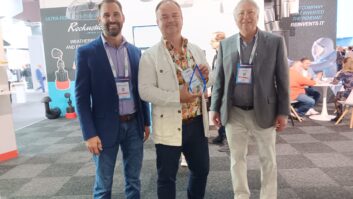SAFETY HARBOR, FLORIDA:
After less than a decade in the business, Chris Sclafani’s results-oriented, artist-centered approach has made him an in-demand recording and mix engineer. His client list includes Selena Gomez, The Weeknd, Gwen Stefani, Sean Paul, and Passion Pit, among many others. More recently, he has worked with Ed Sheeran on Divide, Ariana Grande on Cashmere Cat’s album 9, and Camila Cabello on the single, “Cryin’ in the Club.” After cutting great vocals, guitars, drums, and other instruments with Ed Sheeran (which earned an Album of the Year Grammy Award nomination in 2015 for X), Ed asked him to set up his home studio. Among many other things, Sclafani gave Sheeran a copy of Metric Halo’s legendary ChannelStrip plug-in, which has been Sclafani’s go-to for “literally everything involving vocals and most other things as well.”
Despite growing up decades after their heyday, Sclafani’s older siblings and friends introduced him to the transformative power of music through the classics: the Beatles, Led Zeppelin, and Jimi Hendrix. “Those bands were really important to me because they captured a part of my imagination that, up until that point, I didn’t really know existed,” he said. Like so many others, Sclafani opened that magical door by picking up the bass and the guitar and jamming out his favorite tunes with kids in the neighborhood. Garage jamming led to recording, and it was in that universe that Sclafani found his calling.
“Recording felt like second nature,” he said. “I knew the guitar tone I wanted to get; I knew how I wanted to mic the drums because of all of the research I did to learn how the greats did it. Of course, it’s not that simple (ha!), but we got by just fine for what it was.” Sclafani went to SUNY Fredonia to learn the tools, art, and science of audio engineering and graduated to an entry-level position at Downtown Music Studios in SoHo, New York City. One of his clients was super-producer Benny Blanco, who was so impressed by Sclafani’s work ethic and results that he hired Sclafani as his personal engineer. That, of course, opened a different, more financially-sustaining magical door! Although he freelances these days, Sclafani counts it as lucky that he still gets to work with Blanco on many projects.
“My favorite part of being an engineer is being able to work with an artist or musician and help them capture their sound,” Sclafani said. “A lot of artists these days have something very distinctive about their performance style and want that to come through in their studio works. Whether it’s how their voice emotes, or a certain guitar sound, or how the drums hit, etcetera, they want to hear themselves represented. Being able to sit in a room with them and capture what they do is one of the more exciting parts of the job for sure. When they sit back, listen to what they’ve recorded, and get excited about what they’re hearing, it lets me know that I’ve done my job right. That makes me just as happy as they are.” Although it sometimes masks the credit he deserves for ably running a challenging session, Sclafani adheres to the Futurama quote, “When you do things right, people won’t be sure you’ve done anything at all.”
Sclafani discovered Metric Halo’s ChannelStrip plug-in early in his career, while he was still assisting at Downtown Music Studios. He didn’t have a ton of experience with plug-ins at the time, and he experimented with all the different manufacturers in all the different categories of plug-in. “When it comes to engineering, my philosophy is to try and capture the essence of what the performance is: the emotion, inflection, dynamics, phrasing, intensity, and other things people will feel and connect with,” he said. “As an engineer, I’m trying to capture what this person is and does, not to make it my own sonic experiment and create something that only I want to hear. I have to be true to the performance while at the same time putting my little ‘sonic thumbprint’ on it, knowing it’s what I’ve done and how I’ve processed the signal to make it what it is… so people all over the world can hear and feel it.”
He continued, “Metric Halo ChannelStrip was and is my favorite EQ by far. It lets me carve up problem spots by notch filtering as well as shape the source to sound full and clear. I use it on all my vocal tracks as well as acoustics, keys of all types, and drums, to name a few things. Also, the compressor can really squash things in a beautifully musical way! Being able to use the ChannelStrip EQ in conjunction with the compressor can really help shape an instrument to stand out in the mix with ease. It’s the first EQ I go to when starting to shape vocal sounds, whether it be during tracking to give the singer a little more high end or afterwards when I’m doing more vocal production and helping the track sit in the mix.”
When he was setting up Ed Sheeran’s home studio with Joe Rubel over the summer of 2016, there were certain “must-have plug-ins,” and Metric Halo ChannelStrip was at the top of the list. He also put it in a mobile rig that he put together to record song ideas and parts for Ed Sheeran and Benny Blanco on the road. Part of that work ended up on Justin Bieber’s album Purpose, which earned Sclafani his second Grammy Award nomination (Album of the Year, 2017). “This summer, I’ll be going on tour with Ed and Benny Blanco again to start work on the next project,” he said. “On both my bus rig and the rig I set up in the venue, you can bet Metric Halo ChannelStrip will be front and center!”
ABOUT METRIC HALO
Based on the Gulf Coast of Florida, Metric Halo provides the world with award-winning software and hardware recording, processing, metering and analysis solutions.










